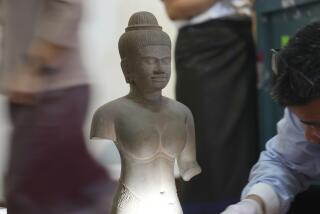Angkor Wat : Restoration on Cambodia Shrine Begins
- Share via
ANGKOR, Cambodia — Since it was abandoned in the 15th Century as the capital of a once-powerful Cambodian empire, Angkor has been ravaged by weather and vegetation, thieves and vandals. During the last 20 years of guerrilla fighting in the region, little has been done to restore its ancient edifices. Now help is on the way, from several corners of the world.
With the shadows of war receding from ancient Angkor, the international community is mobilizing to rescue from decay one of civilization’s greatest artistic achievements.
The Hindu and Buddhist edifices, dating from the 9th through 12th centuries, have been assaulted by jungle growth, monsoon rains and thieves as armies clashed around them over the last two decades.
India, the only non-communist nation to recognize the pro-Hanoi government in Phnom Penh, is already restoring the colossal Angkor Wat, the crowning jewel, but hundreds of other temples and architectural relics from Cambodia’s Golden Age remain untended.
Security has been a major problem in recent years, with the Khmer Rouge and other anti-government guerrillas within striking distance of Angkor. And diplomatic isolation of the Phnom Penh government has prevented most international assistance.
While the guerrillas remain a potential threat, there is optimism that a peaceful political solution may be reached after the promised withdrawal of Vietnamese troops from Cambodia in September.
“We are waiting for the first available opportunity to restore the magnificent monuments,” said Mahfuz Anam, regional spokesman for the U.N. Educational, Scientific and Cultural Organization. “UNESCO’s director general is hopeful of a political solution.”
Although it is restricted from working with the Phnom Penh government, which the United Nations does not recognize, UNESCO this spring quietly dispatched two experts for a preliminary, on-site diagnosis of Angkor’s ills.
UNESCO may help organize an international symposium on Angkor and eventually launch a worldwide fund-raising campaign, similar to those that helped resurrect Egypt’s pyramids, Indonesia’s Borobudur temple and the ancient North African city of Carthage.
“Everyone wants to get involved in Angkor,” said one Western aid official in Phnom Penh.
Ung Von, who heads Cambodia’s conservation effort here, said a group of Poles will arrive late this year to begin work on the Bayon, an intricate, 800-year-old shrine of mysterious galleries and 54 stone towers sculpted with the faces of smiling deities.
The wondrous structure is currently looked after by two old sweepers and guarded by two teen-age policemen. Its eastern gate caved in several years ago. Green algae and white fungi mar its friezes of ancient battles and court life.
The French, who hacked Angkor out of the jungle in the last century and became its most expert overseers, refuse to provide valuable archival material to Phnom Penh but have asked to restore the 11th-Century Baphuon, Ung Von said.
The Indians are midway through their six-year, $10-million project to renew Angkor Wat, a massive representation of the Hindu cosmos in stone which rises in three successive flights to five central towers that have become the symbol of Cambodia.
The work by 13 Indians and more than 400 Cambodians has included cleaning the friezes, dismantling and reassembling the gateways, and excavating ditches to allow water to drain within the moat-girded complex.
The work on Angkor Wat’s nearly 1,440 square yards of friezes is painstaking. Brushes are used to scrub off moss, insect nests and clinging vegetation, the latter sometimes requiring injections of weed killer in a syringe. Other chemicals are used to attack fungi, micro-vegetable matter and corrosive bat droppings before a protective coating is applied.
Heavy machinery is limited to the occasional use of a borrowed crane. Obtaining construction supplies such as cement is a logistical nightmare. Work proceeds with the use of hands, hoes and bamboo baskets, not unlike the way Angkor Wat was probably constructed.
Some old, expert craftsmen who had worked with the French have returned but Ung Von said local expertise was decimated during the Khmer Rouge rule and by lack of training since. Some also criticize the Indians.
“They need our help,” Ung Von said. “Sometimes they don’t have the experience. They have done their job well, but their technique is different from the French.”
Some Cambodians and Westerners say privately that the Indian team uses inferior chemicals, is reassembling galleries in a way that allows water seepage, and is stubbornly clinging to some techniques abandoned by international leaders in conservation.
But an expert, independent evaluation of their work has yet to be made and the Cambodians are reluctant to criticize publicly because they have made a major political issue of non-communist India coming to their aid.
The Indian restoration, which began in 1987, was the first meaningful attempt to keep the rapid deterioration at bay since French archeologist Bernard-Phillipe Groslier was expelled from Angkor by the Khmer Rouge in 1972.
Angkor has fought against the elements since being abandoned in the 15th Century as the capital of a once-powerful Cambodian empire. The Khmer Rouge occupied the area during their war against the U.S.-backed government in Phnom Penh and did nothing to restore Angkor during their brutal time in power.
Since 1979, the pro-Hanoi government has made efforts, but with few resources and little expertise. Now, said Ung Von, there are prospects for real progress, and small numbers of foreign tourists are starting to return.
“I feel like a sick man who is starting to feel well again,” he said.
More to Read
Sign up for Essential California
The most important California stories and recommendations in your inbox every morning.
You may occasionally receive promotional content from the Los Angeles Times.













